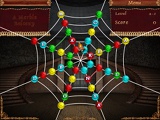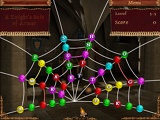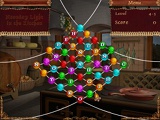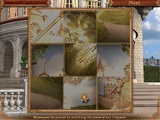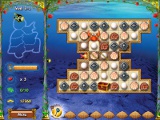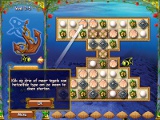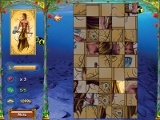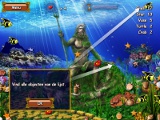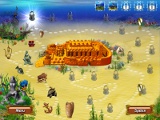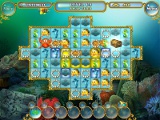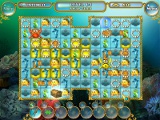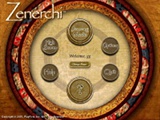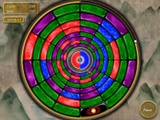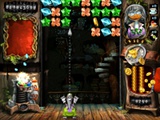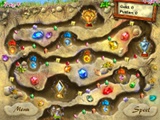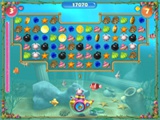





Rainbow Web Bundle - 2 in 1:
Rainbow Web (demo)
Rainbow Web II (demo)
Rainbow Web was an Acer GameZone demo, with music only slightly less annoying than that of Age of Emerald. The Rainbow Kingdom is a place full of scenic beauty, hidden from the eyes of ordinary mortals. Jealous of its inhabitant's happy smiles, an evil wizard called Spider spins a web to cast it into shadows, but a kindly wizard opens a portal to this world so that you, yes YOU, may save the Magic Kingdom by knocking lettered beads off a spiderweb. The story, as told on a scroll you happen to find in the park, ends on: "So, go forth, brave savior." I shit you not.
For all the gravity of its backstory, the game is childishly simple, the sort of game I'd give to tiny tots. There is a spiderweb. Beads of different colours can be slid over its threads to line up three or more of the same colour, which will then go poof, more beads moving out from the centre of the web. Some beads have letters on them, and these beads must absolutely be made to go poof, so that the letters, freed from the web, will move to the top right corner to make a word of phrase; for example, "pathway" or "fulvous hut". Once all letters are free, the object of that description will then appear: there, another bit of Rainbow Kingdom freed, and a great way to teach children new words, although, "fulvous hut"?
The game can be played in timed or relaxed mode, the timer being the slowly retracting tongue of a barely noticeable chameleon in the bottom left corner. As the player goes through the levels, little difficulties are added, like new bead colours and missing web threads, limiting the number of directions in which the beads can be moved. Despite its original take on the match-3 genre, I wasn't too impressed with this game at first, but it's an amusing way to pass the time.
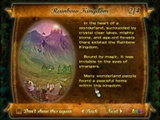
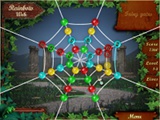
I installed Rainbow Web II (or "2", but the game uses Roman
numerals) bundled with its predecessor, because I had the impression that it was
a hidden object game. It does have interim games where I have to find hidden
fragments of an object, but it's mostly knocking beads off a spider's web as
before, only now the webs take on new and amazing shapes. Wasn't the kingdom
saved from that evil sorcerer Spider, I hear you ask? Well, yes, but he's still
skulking inside the castle. Against a background of courtly music, further
emphasizing the usual harp chord that sounds when beads are popped, the player
must find a way of entering the castle by making a picture out of shuffled
squares (the first type of minigame), collect the half-hidden shards of a
special vase (the second type of minigame, with self-recharging hint button) and
then solve one spider's web after another, starting with the standard wheel type
and moving onto strange variations. For each room entered, there are several
cobwebs to clean, causing the room to fill up with "freed" objects. Instead of
the outdoor scenes, this is all about castle interiors, and very posh and and
inviting interiors they are.
As the previous game would be suitable for tiny tots, this game is for the
slightly larger tots, as the words and phrases are longer. There is still the
black/white morality and overblown hero-worshipping tone, as the game shows a
message after every completed level to tell me how I've struck yet another blow
against Evil. But small children tend to automatically skip such waffle.
The evil sorceror Spider just will not die: there is a Rainbow Web 3 out,
with even prettier graphics and more psychedelic webs.
Hidden Wonders Of The Depths or Atlantica,
1 and 2
These are my favourite match-3 games. I bought part 1 in the
supermarket under its Dutch name, Atlantica; Hidden Wonders of the Depths is the
original English title. Because of the title change, I had some problems finding
its sequel on the Oberon site, confusing it with the Atlantis game pack. The
original is not just match-3; I have to line up the tiles to free the way for a
little crab to follow a set course over the board. The crab is adorable and
makes little "babababap" sounds. Match-3 games are alternated with memory games
and samegames (screenshots 1 and 2) using the same tiles. In both match-3 and
samegame, I have to "destroy" certain squares (by lining tiles up over them so
that they disappear) and this frees up fragments and puzzle pieces; the
fragments are added to whatever object the levels are trying to complete as part
of making a new house and inventory for a mermaid, and the house itself - that
golden mansion in the middle of screenshot 5 - has some parts added to it.
When enough puzzle pieces have been gathered, the game offers me a "magic
card" to fix by switching tiles (screenshot 3), which then gives me a certain
power: smash one tile, destroy a line of tiles, add time to clock etc. It also
frees up "underwater inhabitants" (ie. fish) who really get in the way by
swimming all over the place in the four hidden object games (screenshot 4) that
make up the game's bonus levels, and where I have to click away shells, stars,
coins, vases, crabs and turtles as fast as I spot them - if I wait for a bit,
unfound items will waggle to draw my attention. Still, this is where I lost a
lot of lives. That's another thing freed up by destroying squares: new lives. I
start out with three and, if I'm careful, can amass something like twenty. If I
lose all lives halfway through the game, I can restart the game from that point
with three new lives, but the score is reset to zero. Once the player gets
enough feel for the game to finish even the most awkward levels (squares with
double chains on them, arranged in such a way that lining up tiles is very hard)
with lives to spare, there is still the challenge of getting the highest score,
with bonuses for the largest number of tiles you can line up or the most
consecutive tile matches you can make in the memory game.
The second game, bought in English (not that it makes much of a
difference as there's not much text in it) is fluffier and more "aero" in
appearance, with rounded edges to everything including the magic cards. I don't
like it as much as the older game, but maybe that's just nostalgia. The hidden
object games have less objects to find, but they're hidden slightly better, and
the points you score are now collected gold, and have a function: to buy stuff.
Having made the mermaid a home in the last game, the little crab now has a
different mission: to buy fish and a boat for a world trip. Still making bapping
sounds, it now also blows raspberries and does rockstar impressions, while its
friend, a crab with a moustache and goatee (French?) periodically giggles, a
very unsettling sound effect. Yes, there are now two crabs, having to follow two
routes on the board of tiles. On the upside, the game has a "relaxed" mode,
without timer. Since the game is supposed to take me on a trip around the world,
the hidden object game shows a different screen for every location, and some are
quite visually dramatic. Along with match-3, samegame and the tile-flipping
memory game, a fourth game has been added where I have to move tiles to put
three or more together while the playfield fills up with more tiles. It took me
a while to get the hang of it, but now it's my favourite game.
Zenerchi from Goodie Bag Bundle - 3 in 1
Supposed to be a new take on the match-3 concept, like Rainbow
Web, and have relaxing background music, this game was a disappointment, as
neither graphics nor music appealed to me. The playfield is round, like a car's
driving wheel, and circles have to be pulled around to line up "tiles" in spokes
of the same colour. Per level, the game sets me two to four colours that I can
collect points for to win more time, the big tiles on the outside of the circle
being worth more than the little ones near the centre. Lining up five tiles gets
me a bonus tile that lets me destroy or recolour surrounding tiles. Obstacles
are introduced as the player progresses: locked tiles, tiles that cling together
and a mechanism that makes two circles revolve in opposite directions. There is
a Zen Mode and a Story Mode, the latter with a timer that usually runs out after
I've reached the Expert score, but before I've been able to collect enough
points for each colour.
Diamond Drop 2
This game was bought from the bargain bin of a DIY chain and has, hands down,
the worst Dutch translation I've ever seen. It's as if the text was run through
a translation machine, giving literal translations of expressions like "legal
eagle". If I hadn't been able to guess the English behind the Dutch, the
gibberish dialogue that tells the game's story wouldn't have made sense to me.
What is the story: in a village of anthropomorphic animals, a near-sighted
mole mines diamonds and makes them into jewellery for the local ladies (and
occasionally gentlemen). His mining rights are running out, and to renew them he
will have to compete with a new arrival, a smooth customer who threatens to not
only take over the mine but also steal away the second new arrival, a pretty
mole-girl. The mole miner does what he can to win her heart, failing all the way
- if the translated text wasn't so horrid, this would make a funny read - until
it turns out that all the smooth customer came to steal is the possessions of
everyone in the village. The mole miner apprehends him, becomes the village
hero, has his mining rights renewed and, of course, gets the girl. None of this
action is visible, the player just has to knock diamonds from the ceiling and
assume this achieves what the game dialogue says it does.
The first screenshot shows how the game works: you have to grab one or more
of the precious stones descending from the ceiling and throw them up again at
stones of the same colour; if three or more stones of the same colour are
clustered together, they disappear. As such, this is somewhere between a match-3
game and a samegame. For every disappearing stone, some weight is added to the
scales until they are full, and a piece of jewellery is considered finished and
flies to the customer in the top right corner, who may be pleased, neutral or
downright grouchy depending on how long the wait was; customer patience can be
extended by feeding them coffee, cake and sweets, and the jewellery-making
options can be upgraded to increase value, making this game a hybrid of match-3,
samegame and time management. Interspersed with the precious stones are bonuses,
"frozen" stones that need two hits to free them, coins that have to be caught
when they drop and rocks that hit the character on the head, wiping whatever the
character was holding and making him dizzy for a few seconds. When a piece of
jewellery is sold - and the longer it takes to finish, the more its value drops
- the money is added to the safe on the right, and when the safe is full, the
day ends, either in fireworks if the day's target is met, or in depression and a
replay of the level (but the player keeps the money) if it isn't, and the target
is higher every day. Screenshot 2 shows the mission levels as gems in a mine
shaft, and the awards that the character receives every four or so levels, up to
the big trophy at the end.
Okay. The game demands faster reaction speeds than mine, but is otherwise
quite original. However, the mole miner is a selfish bastard with a derpy-derp
face (no, 3D character design is not always cute and funny). The customers are
unreasonably impatient, the village as a whole so mean-spirited that I'm
practically cheering on the cardboard villain, and the awful translation just
clinches it. If it wasn't for Super Nautica that comes bundled
with it, I would have considered the game a waste of even the two euros it cost
me.
Super Nautica or Golden Submarine
Once a separate game but now bundled with Diamond Drop 2 is
the delightfully simple game Golden Submarine, titled Super Nautica in Dutch,
where a submarine must shoot shells and other sea-themed items upwards into an
overhead frame to bring down the coins. Each shot costs oxygen, but each caught
coin adds some (coins picked up off the floor add some too, but less) and in all
the submarine must get the coins before running out of air, which will make it
spin round and fizzle out, after which the level has to be replayed. (After
three times, your "lives" are up and you can still go on playing where you left
off, but with your score reset to zero.) Each level is tiny, but there are very
many of them, and both bonuses (like shotgun bullets) and obstacles ("frozen"
tiles, weights that drop on the submarine and knock it out for a moment) are
introduced as the player progresses. So, the game plays a lot like iamond Drop
2, except there's nothing irritating about it, and no back story. The game
executable is very small, suggesting that the game is an old one; I suspect this
was a pioneer in its genre.
